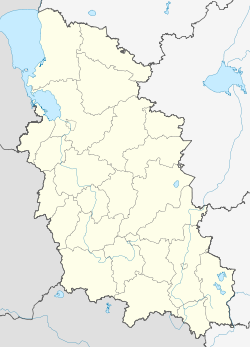Porchow
| city
Porchow
Porhov
|
||||||||||||||||||||||||||||||||||||||||
|
||||||||||||||||||||||||||||||||||||||||
|
||||||||||||||||||||||||||||||||||||||||
| List of cities in Russia | ||||||||||||||||||||||||||||||||||||||||
Porchow ( Russian Порхов ) is a city in the northwestern Russian Oblast Pskov with 10,608 inhabitants (as of October 14, 2010).
geography
The city is located about 90 km east of the Oblast capital Pskow on the river Schelon, which flows into the Ilmen Lake .
Porchow is the administrative center of the Rajons of the same name .
The city lies on the railway line Bologoje - Dno - Pskow (- Tartu - Tallinn ), opened in 1897 .
history
Porchow was founded in 1239 by Prince Alexander Jaroslawitsch (later "Newski") as a fortress to protect the south-western entrances to the Novgorod Republic . The original wooden fortress burned down in 1387 and was immediately rebuilt from limestone 1,300 meters downstream. It was damaged several times in conflicts with the Grand Duchy of Lithuania , for example in 1356 under Algirdas and 1428 under Vytautas .
In 1478 the fortress and the entire Novgorod Republic fell to the Grand Duchy of Moscow and was consequently one of the 12 most important fortresses along its western border.
In the 18th century, the area around the fortress developed into an important trade center for linen . In 1777 Porchow received city rights as the administrative center of a district (Ujesds) of the Pskow governorate . In the 19th century and until 1918 there was an Estonian-speaking Lutheran parish in Porchow.
During the Second World War , Porchow was occupied by German troops on July 11, 1941 and recaptured on February 26, 1944 by troops of the Leningrad Front of the Red Army as part of the Leningrad-Novgorod Operation . In the course of the fighting, 90 percent of the city was destroyed. Bertolt Brecht's son Frank Banholzer died here in 1943 in a bomb attack against a Wehrmacht cinema. He was buried in the “Heroes Cemetery Porchow”.
Population development
| year | Residents |
|---|---|
| 1897 | 5,551 |
| 1926 | 8,000 |
| 1939 | 12,681 |
| 1959 | 7,639 |
| 1970 | 10,977 |
| 1979 | 13,441 |
| 1989 | 14,170 |
| 2002 | 12,263 |
| 2010 | 10,608 |
Note: census data (1926 rounded)
Culture and sights
In addition to the partially destroyed fortress several churches have been preserved in the city, the Church of the Redeemer ( Спасская церковь / Spasskaya Zerkow) of 1650 (origins of 1399) that Maria Birth Church ( Рождественская / Roschdestwenskaja Zerkow) and the Nikolai Church ( Никольская / Nikolskaya zerkow) (both early 15th century).
A history and local museum is located on the site of the former fortress .
17 kilometers southeast of the city on the banks of the Schelon is the former estate of Prince Gagarin Cholomki with the main building from 1913 (architect Iwan Fomin ) and a park. At the beginning of the 1920s there was a colony of artists and writers here and in the neighboring Belskoye estate , where poets and writers such as Vladislav Khodasevich , Evgeny Zamyatin , Mikhail Soschtschenko and Kornei Tschukowski lived and worked for a time.
18 kilometers southeast of Porchow in the village of Wolyschowo is the former residence of Count Stroganow with a 100 hectare landscaped park.
economy
In Porchow there are companies in the building materials industry (limestone), electrical engineering (relay) and the food industry.
Web links
- Official city portal (Russian)
- Porchow on mojgorod.ru (Russian)
Individual evidence
- ↑ a b Itogi Vserossijskoj perepisi naselenija 2010 goda. Tom 1. Čislennostʹ i razmeščenie naselenija (Results of the All-Russian Census 2010. Volume 1. Number and distribution of the population). Tables 5 , pp. 12-209; 11 , pp. 312–979 (download from the website of the Federal Service for State Statistics of the Russian Federation)
- ^ Support fund for Evangelical Lutheran congregations in Russia (ed.): The Evangelical Lutheran congregations in Russia. A historical-statistical representation . Vol. 1: The St. Petersburg and Moscow consistorial districts . Watsar, Saint Petersburg 1909, p. 170.
- ↑ Wolfgang Conrad, Ernst-Ullrich Pinkert, Erich Unglaub: Brecht's sons. Topography, biography, work . Peter Lang, Frankfurt am Main 2008, ISBN 978-3-631-58376-0 , p. 41.





